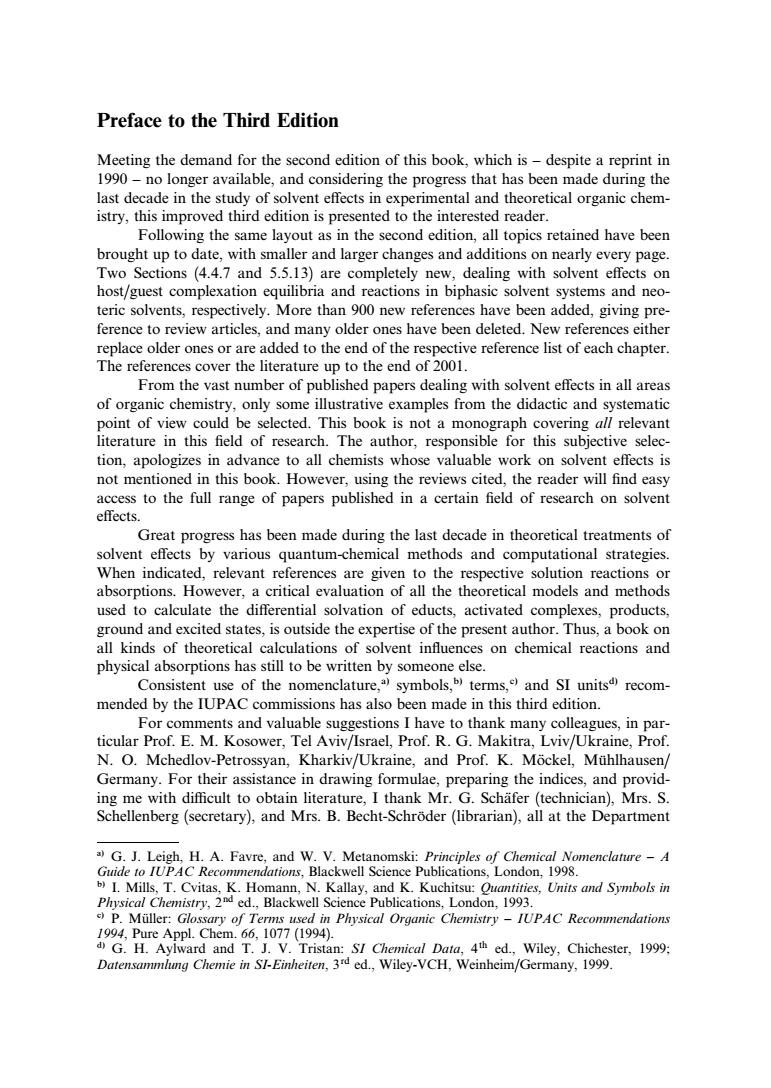正在加载图片...

Preface to the Third Edition Meeting the demand for the second edition of this book,which is-despite a reprint in 1990-no longer available,and considering the progress that has been made during the last decade in the study of solvent effects in expe ntal and theoretical organic chem istry,this im ved third edit n is n esented to the interested re der Following the same layout as in the sec ond edition all to ics retained have beer brought up to date. with smaller and larger chang and additio ns(4.4.7and5.5.13)are ith soly pag dealing host/guest co equilibria and i s in biphasic olvent syste ms and ne olvents ely more than 900 ney added.giving S P and n older olde dded he The list of ea ch chapter he lite th f200i the st nur f pu papers deali ng with solve efects in all ar f orga che didacti oint of uld on selected.Th examples from the this field not a mo The resp apo 0 review d in a certain field reade ffects Great progress has been made during the last decade in theoretical treatments solvent effects by various quantum-chemical meth ods and computational strategie When indicate d,relevant references are given to solution reactions o absorptions. However,a critical evaluation o all the the l models and method used to calculate the differential solvation of educts,activated complexes,products. ground and excited states,is outside the expertise of the present author.Thus,a book on all kinds of theoretical calculations of solvent influences on chemical reactions and physical absorptions has still to be written by someone else. Consistent use of the nomenclature.symbols.terms.and SI units recom mended by the IUPAC commissions has also been made in this third edition. For comments and valuable suggestions I have to thank many colleagues,in par ticular Prof.E.M.Kosower,Tel Aviv/Israel,Prof.R.G.Makitra,Lviv/Ukraine,Prof N.O.Mchedlov-Petrossyan,Kharkiv/Ukraine,and Prof.K.Mockel,Muhlhausen/ Germany.For their assistance in drawing formulae,preparing the indices,and provid ing me with difficult to obtain literature,I thank Mr.G.Schafer(technician),Mrs.S. Schellenberg (secretary),and Mrs.B.Becht-Schroder (librarian),all at the Department G.J.Leigh. and W V.Met ski- ePublications,London,1998 menclature-A U AC Recom es Units and Symbols in in Physical Organic Chemistry-IUPAC Recommendations Tristan:SI Chemical Data,4th ed.,Wiley,Chichester,1999: Datensammlung Chemie in SI-Einheiten,3d ed.,Wiley-VCH,Weinheim/Germany,1999. Preface to the Third Edition Meeting the demand for the second edition of this book, which is – despite a reprint in 1990 – no longer available, and considering the progress that has been made during the last decade in the study of solvent e¤ects in experimental and theoretical organic chemistry, this improved third edition is presented to the interested reader. Following the same layout as in the second edition, all topics retained have been brought up to date, with smaller and larger changes and additions on nearly every page. Two Sections (4.4.7 and 5.5.13) are completely new, dealing with solvent e¤ects on host/guest complexation equilibria and reactions in biphasic solvent systems and neoteric solvents, respectively. More than 900 new references have been added, giving preference to review articles, and many older ones have been deleted. New references either replace older ones or are added to the end of the respective reference list of each chapter. The references cover the literature up to the end of 2001. From the vast number of published papers dealing with solvent e¤ects in all areas of organic chemistry, only some illustrative examples from the didactic and systematic point of view could be selected. This book is not a monograph covering all relevant literature in this field of research. The author, responsible for this subjective selection, apologizes in advance to all chemists whose valuable work on solvent e¤ects is not mentioned in this book. However, using the reviews cited, the reader will find easy access to the full range of papers published in a certain field of research on solvent e¤ects. Great progress has been made during the last decade in theoretical treatments of solvent e¤ects by various quantum-chemical methods and computational strategies. When indicated, relevant references are given to the respective solution reactions or absorptions. However, a critical evaluation of all the theoretical models and methods used to calculate the di¤erential solvation of educts, activated complexes, products, ground and excited states, is outside the expertise of the present author. Thus, a book on all kinds of theoretical calculations of solvent influences on chemical reactions and physical absorptions has still to be written by someone else. Consistent use of the nomenclature,a) symbols,b) terms,c) and SI unitsd) recommended by the IUPAC commissions has also been made in this third edition. For comments and valuable suggestions I have to thank many colleagues, in particular Prof. E. M. Kosower, Tel Aviv/Israel, Prof. R. G. Makitra, Lviv/Ukraine, Prof. N. O. Mchedlov-Petrossyan, Kharkiv/Ukraine, and Prof. K. Mo¨ckel, Mu¨hlhausen/ Germany. For their assistance in drawing formulae, preparing the indices, and providing me with di‰cult to obtain literature, I thank Mr. G. Scha¨fer (technician), Mrs. S. Schellenberg (secretary), and Mrs. B. Becht-Schro¨der (librarian), all at the Department a) G. J. Leigh, H. A. Favre, and W. V. Metanomski: Principles of Chemical Nomenclature – A Guide to IUPAC Recommendations, Blackwell Science Publications, London, 1998. b) I. Mills, T. Cvitas, K. Homann, N. Kallay, and K. Kuchitsu: Quantities, Units and Symbols in Physical Chemistry, 2nd ed., Blackwell Science Publications, London, 1993. c) P. Mu¨ller: Glossary of Terms used in Physical Organic Chemistry – IUPAC Recommendations 1994, Pure Appl. Chem. 66, 1077 (1994). d) G. H. Aylward and T. J. V. Tristan: SI Chemical Data, 4th ed., Wiley, Chichester, 1999; Datensammlung Chemie in SI-Einheiten, 3rd ed., Wiley-VCH, Weinheim/Germany, 1999